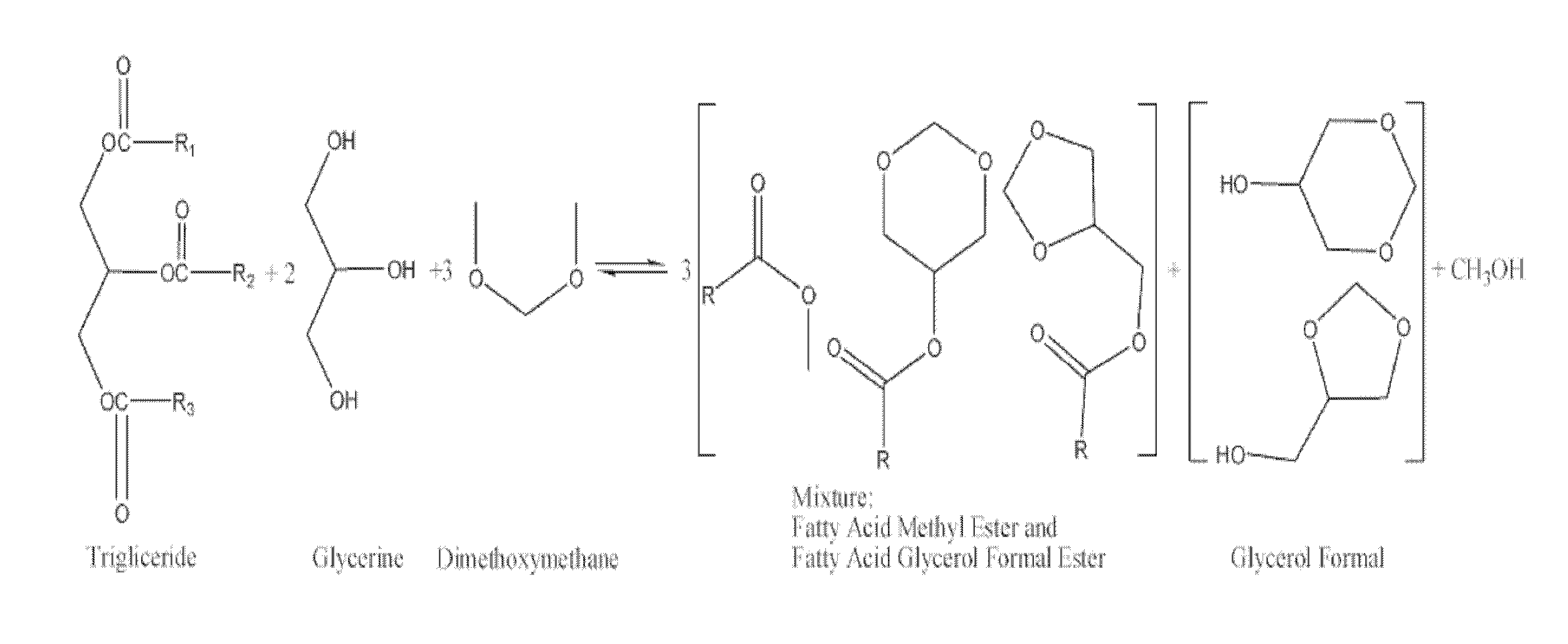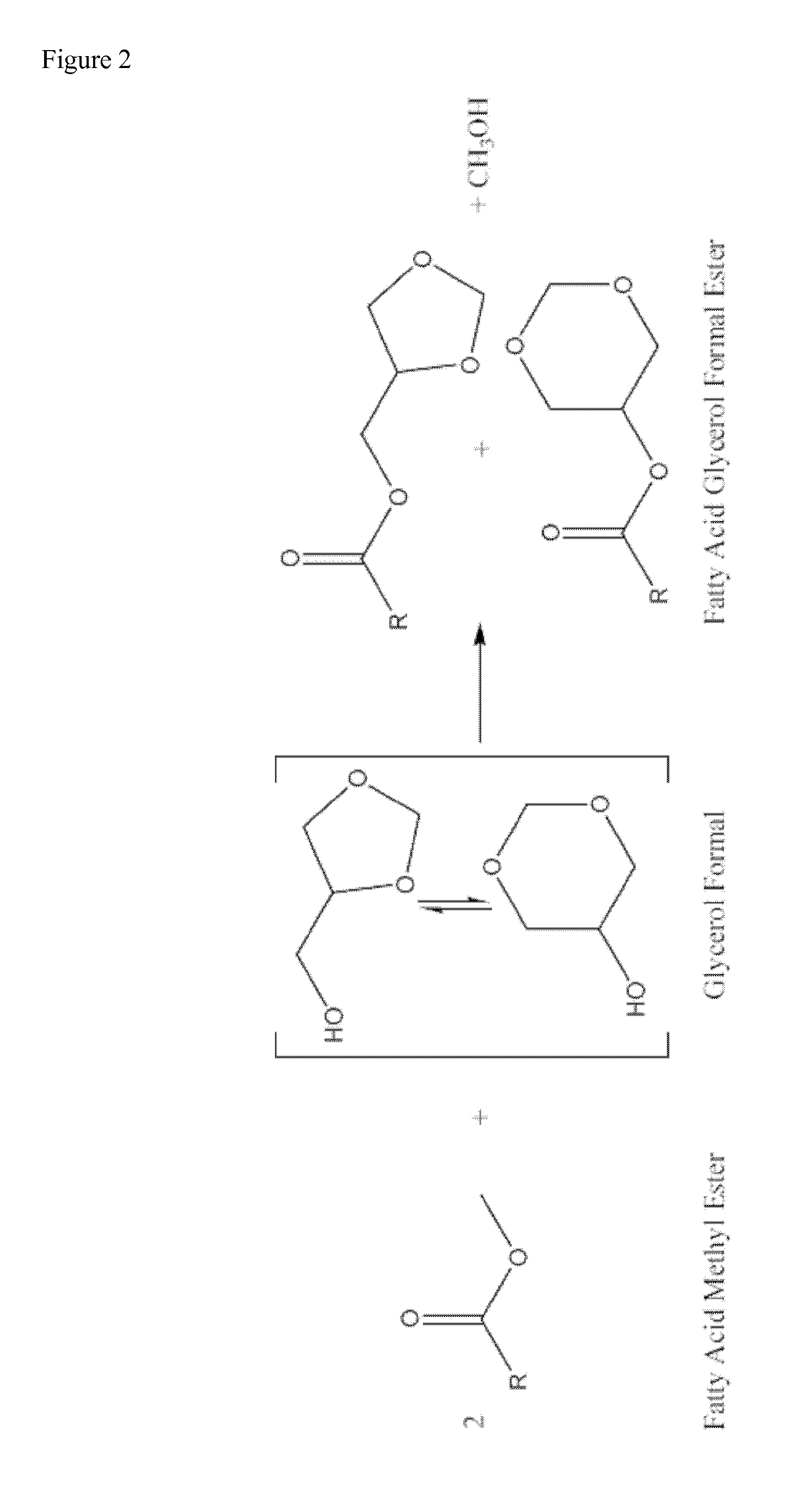Process for manufacturing biofuels
a biofuel and processing technology, applied in the direction of biofuels, fuels, fatty acids chemical modification, etc., can solve the problems of inability to obtain glycerol, inefficient resource utilization, and inability to meet the needs of large-volume commodities,
- Summary
- Abstract
- Description
- Claims
- Application Information
AI Technical Summary
Benefits of technology
Problems solved by technology
Method used
Image
Examples
example 1
[0050]79.0 g of soy oil (0.093 mol, 1.000 eq), 28.12 g of glycerol (99% glycerol w / w) (0.306 mol, 3.305 eq), 105.78 g of dimethoxymethane (1.390 mol, 15.03 eq), and 6.32 g of sulfuric acid (0.064 mol, 0.697 eq.) were added to a closed vessel. The mixture was stirred at 290 rpm and heated at 70° C. The reaction mixture was maintained at 70° C. and 1.5 bar for 10 hours. Two layers were separated by decantation. The upper layer containing excess of dimethoxymethane, methanol and a mixture of fatty acid methyl esters and fatty acid glycerol formal esters was subjected to distillation at atmospheric pressure. The fraction distilled at 42° C. corresponds to pure dimethoxymethane (82.40 g, 1.083 mol, 11.71 eq) which is recycled in the process without further treatment. Subsequently, a fraction distilling at 65° C. corresponding to pure methanol (9.32 g, 0.291 mol, 3.145 eq.) was obtained. The resulting mixture after distillation of volatile compounds was neutralised wi...
example 2
[0051]70.90 g of soy oil (0.083 mol, 1.000 eq), 31.91 g of glycerol (99% glycerol w / w) (0.347 mol, 4.177 eq), 165.84 g of dimethoxymethane (2.179 mol, 26.24 eq), and 7.44 g of sulfuric acid (0.076 mol, 0.914 eq.) were added to a closed vessel. The mixture was stirred at 290 rpm and heated at 70° C. The reaction mixture was maintained at 70° C. and 1.5 bar for 2 hours. Two layers were separated by decantation. The upper layer containing excess of dimethoxymethane, methanol and a mixture of fatty acid methyl esters and fatty acid glycerol formal esters was neutralised with a basic ion exchange resin and then subjected to distillation at atmospheric pressure. The fraction distilled at 42° C. corresponds to pure dimethoxymethane (122.37 g, 1.608 mol, 19.369 eq) which is recycled in the process without further treatment. Subsequently, a fraction distilling at 65° C. corresponding to pure methanol (14.82 g, 0.462 mol, 5.571 eq.) was obtained. The resulting mixture was...
example 3
[0052]143.60 g of soy oil (0.168 mol, 1.000 eq), 46.24 g of glycerol (99% glycerol w / w) (0.503 mol, 2.989 eq), 210.09 g of dimethoxymethane (2.761 mol, 16.418 eq), and 17.66 g of an acidic ionic exchange resin were added to a closed vessel. The mixture was stirred at 290 rpm and heated at 85° C. The reaction mixture was maintained at 85° C. and 1.5 bar for 6 hours. The catalyst was then filtered and the resulting mixture was distilled at atmospheric pressure. The fraction distilled at 42° C. corresponds to pure dimethoxymethane (168.16 g, 2.210 mol, 13.141 eq) which is recycled in the process without further treatment. Subsequently, a fraction distilling at 65° C. corresponding to pure methanol (14.36 g, 0.448 mol, 2.665 eq.) was obtained. The resulting mixture after evaporation of volatile compounds was decanted forming two layers. The upper layer containing the mixture of fatty acid methyl esters and fatty acid glycerol formal esters was subjected to a first...
PUM
| Property | Measurement | Unit |
|---|---|---|
| molar ratio | aaaaa | aaaaa |
| molar ratio | aaaaa | aaaaa |
| molar ratio | aaaaa | aaaaa |
Abstract
Description
Claims
Application Information
 Login to View More
Login to View More - R&D Engineer
- R&D Manager
- IP Professional
- Industry Leading Data Capabilities
- Powerful AI technology
- Patent DNA Extraction
Browse by: Latest US Patents, China's latest patents, Technical Efficacy Thesaurus, Application Domain, Technology Topic, Popular Technical Reports.
© 2024 PatSnap. All rights reserved.Legal|Privacy policy|Modern Slavery Act Transparency Statement|Sitemap|About US| Contact US: help@patsnap.com










